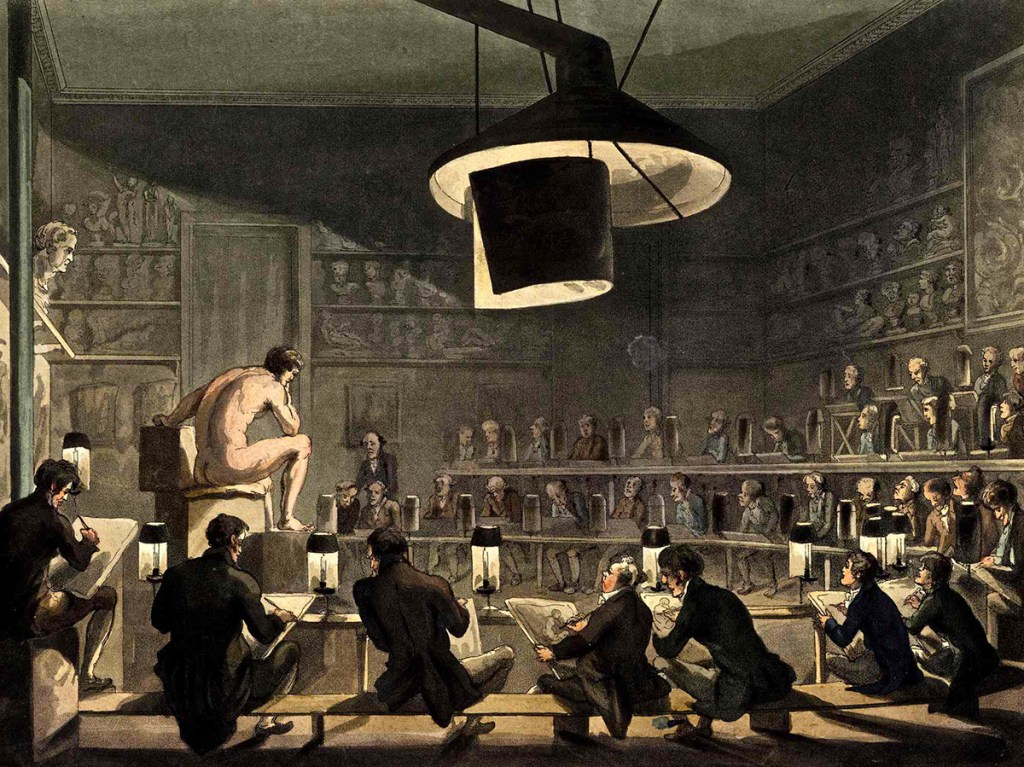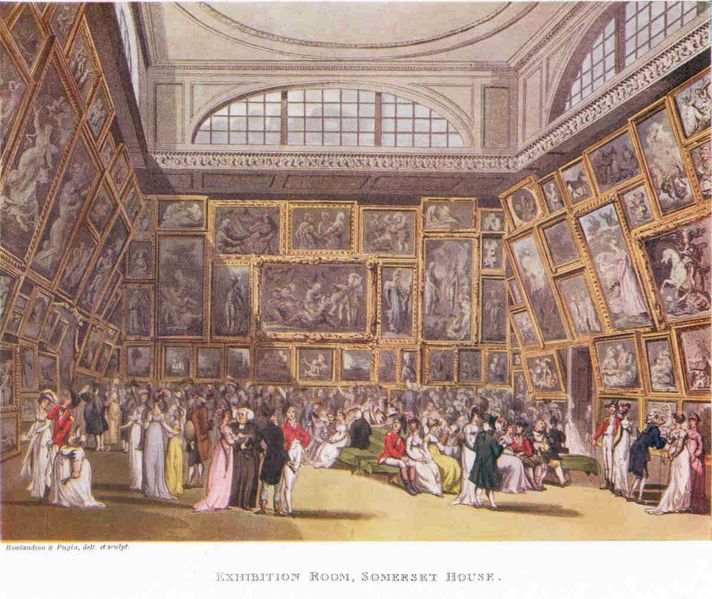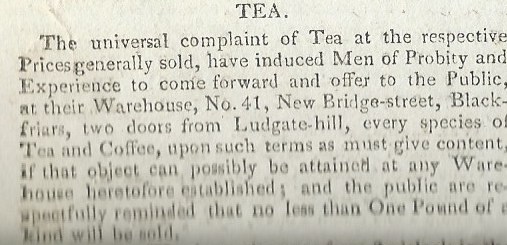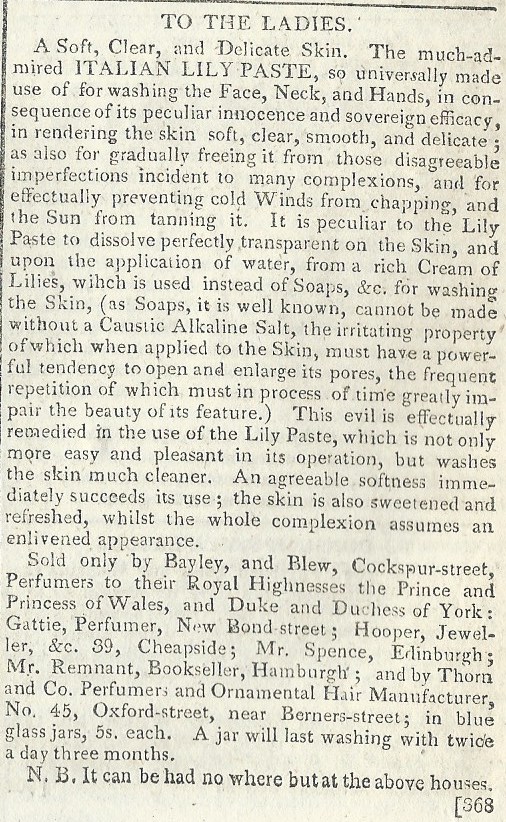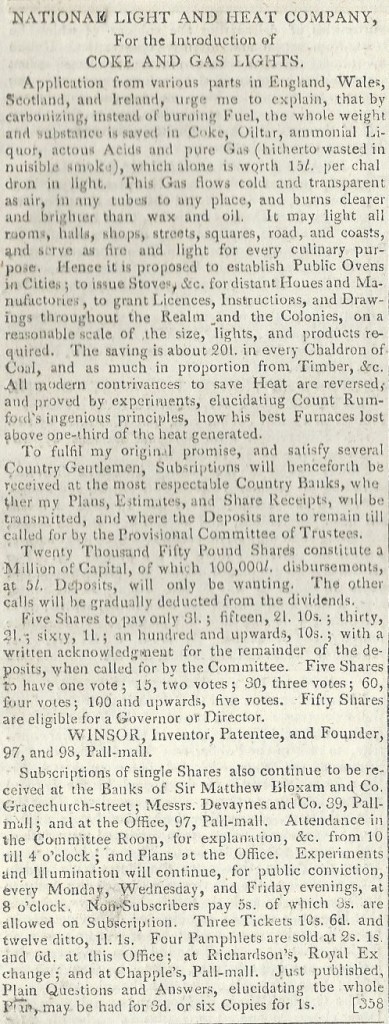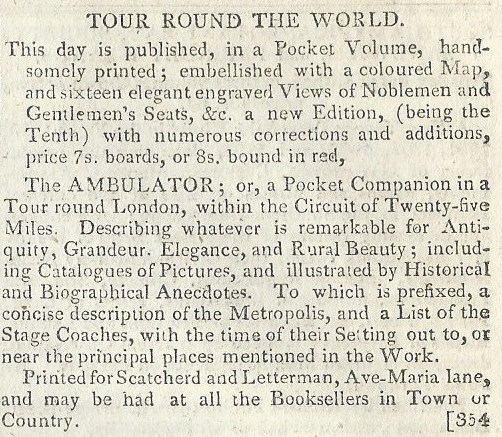published by Rudolph Ackermann in 3 volumes, 1808–1811.
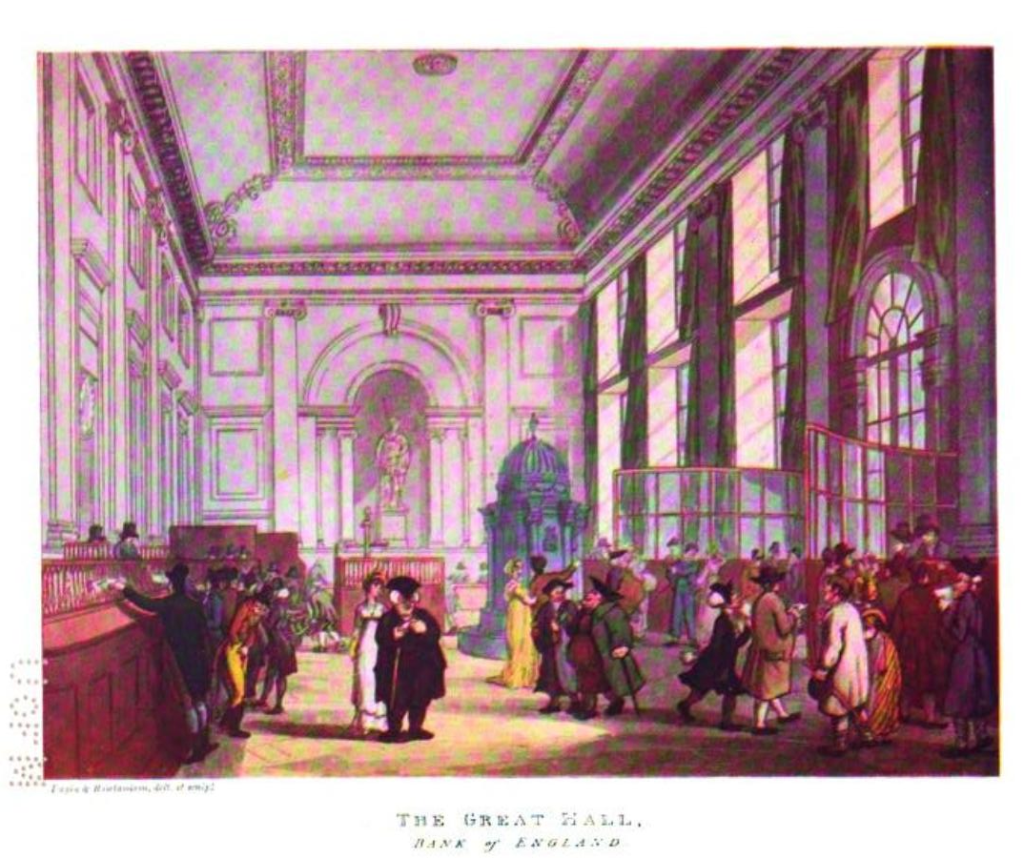
The Great Hall – Bank of England
The annexed print represents the hall in which bank notes are issued and exchanged: it is a noble room, seventy-nine feet by forty, and contains a very fine marble statue of King William the Third, the founder of the Bank; an admired piece of sculpture, and the production of Cheere. The various groups of figures in this hall are well conceived, and the busied and careful countenances of the monied interest, well contrasted with the countryman’s gaping face of astonishment, and the gaiety of the sailor and his chere amie: the perspective is good, and the effect of the whole striking and impressive.
The building called the Bank, is a stone edifice, situated a little to the north of Cornhill. The front, composed of a center eighty feet in length, of the Ionic order, on a rustic base; and two wings, ornamented with a colonnade. The back of the building, which is in Lothbury, is a high and heavy wall of stone, with a gateway for carriages into the bullion-court. The principal entrance into the Bank is from Threadneedle-street. On the east side of this entrance is a passage leading to a very spacious apartment, which is called the Rotunda, where the stock-brokers, stock-jobbers, and other persons meet for the purpose of transacting business in the public funds. Branching out of the Rotunda are the various offices appropriated to the management of each particular stock; in each of these offices, under the several letters of the alphabet, are arranged the books in which the amount of every individual’s interest in such a fund is registered. Here, from the hours of eleven to three, a crowd of eager money-dealers assemble, and avidity of gain displays itself in a variety of shapes, truly ludicrous to the disinterested observer. The jostling and crowding of the jobbers is so excessive, and so loud and clamorous at times are the mingled voices of buyers and sellers, that all distinction of sound is lost in a general uproar: on such occasions, which are not unfrequent, a temporary silence is procured by the beadle or porter of the Bank, in the following manner: Dressed in his robe of office, a scarlet gown, and gold-laced hat, he mounts a kind of pulpit, holding in one hand a silver-headed staff, and in the other a watchman’s rattle. By a powerful exercise of the rattle, he soon silences the vociferous and discordant clamour, and produces a temporary calm.
The Bank of England was first established in the year 1694, partly for the convenience of commerce, and partly also for the emolument of the proprietors; and it is the greatest bank of circulation in Europe. The scheme was projected by Mr. William Paterson, a merchant, and long debated in the Privy Council. At length, by an act of William and Mary, c. 20. it was enacted, that their majesties might grant a commission to take particular subscriptions for 1,200,000/. of any persons, natives or foreigners; whom their majesties were hereby empowered to incorporate, with a yearly allowance of 100,000/ viz. 96,000/. or 8 per cent, for interest till redeemed, and 4000/. to be allowed the intended Bank for charges of management. The corporation was to have the name of “The Governor and Company of the Bank of England;” their said fund to be redeemable upon a year’s notice after the 1st of August, 1705, and payment of the principal, and then the corporation to cease. The company was enabled by this act to purchase lands, &c. unlimitedly, and to enjoy the other usual powers of corporation: their stock was to be transferable. They were restricted from borrowing more than 1,200,000/. except on Parliament funds; and from trading in any merchandise, except in bills of exchange and bullion, and in the sale of such goods as were the produce of lands purchased by the corporation; and all bills obligatory under the seal of the said corporation, were made assignable by endorsement. The charter of incorporation was executed July 27, 1694; which directs, that there be a governor, deputy-governor, and twenty-four directors; and specifies the qualifications of voters and directors, together with other regulations, which have been farther amended and enlarged by subsequent statutes.
In 1697, the Bank was allowed to enlarge its capital stock by an engraftment of 1,001,171/. 10s. This engraftment is said to have been for the support of public credit. In 1696, tallies had been at 40, 50, and 60 per cent, discount, and bank notes at 20 per cent. During the great recoinage of silver which was going on at this time, the Bank had thought proper to discontinue the payment of its notes, which necessarily occasioned their discredit. By this engrafting act, as it was called, the capital stock of the Bank was to be exempted from any tax: no act of the corporation, nor of its court of directors, nor sub-committees, should subject the particular share of any member to forfeiture; but these shares were subject to the payment of all just debts contracted by the corporation: and it was made felony to counterfeit the common seal of the Bank affixed to their sealed bills, or to alter or erase any sum in, or any endorsement on, their sealed notes, signed by order of the said governor and company, or to forge or counterfeit the said bills or notes. This act was judiciously framed for the restoration of public credit; and it served to effect two points, viz. the rescue of the exchequer tallies and orders from the stock-jobbing harpies, by engrafting them into this company; and also cancelling the engrafted bank notes, which had been at 20 per cent, discount, because the government had been greatly deficient in their payments to the Bank; and a good interest was secured to the proprietors of the increased capital. By the statute 6th Anne, c. 22. it was enacted, for securing the credit of the Bank of England, that no other banking company in England should consist of more than six persons, empowered to issue bills or notes payable on demand, or for any time less than six months; which is the only exclusive privilege belonging to the Bank. In pursuance of the 7th Anne, c. 7. the Bank advanced and paid into the Exchequer 400,000/.; making in all 1,600,000/. which it had advanced upon its original annuity of 96,000/. interest, and 4000/. for the expence of management. In pursuance of the same act, the Bank cancelled exchequer bills to the amount of 1,775,027/. 17 s. 10-1/2 d. at 6 per cent, interest: it likewise undertook the circulation of 2,500,000/. of exchequer bills, issued for the supply of the year; and it was at the same time allowed to take subscriptions for doubling its capital: in 1709, therefore, the capital of the Bank amounted to 4,402,343/. 17 s. 10-1/2 d. and it had advanced to government 3,375,027/. 17 s. 10-1/2 d. By a call of 15 per cent, there was paid in and made stock 656,204/. 1 s. 9 d.; and by another call of 10 per cent, in 1710, 501,448/. 12 s. 11 d.: in consequence of these two calls the Bank capital amounted to 5,559,995/. 14s. 8 d. In consideration of the sum of 400,000/. advanced to government without interest, the exclusive privileges of the Bank were prolonged to one year’s notice after the 1st of August, 1732. By the 12th Anne, c. 11. the company obtained an additional term of ten years to the period of their continuance as a corporation; so that they were not to be dissolved but upon a year’s notice after the 1st of August, 1742. In the following year, they first received the subscriptions to a loan for the public service, which had been hitherto usually taken at the Exchequer; but the Bank being found more convenient for monied persons, has usually received them ever since. In pursuance of statute Geo. I. c. 7, 8, 9. in 1717, the Bank delivered up two millions of exchequer bills to be cancelled; and it had therefore, at this time, advanced to government 5,375,027/. 17 s. 10-1/2 d.: it was now agreed to reduce the interest from 6 to 5 per cent. In pursuance of statute 8th Geo. I. c. 24. in 1722, the Bank purchased of the South Sea Company, stock to the amount of 4,000,000/.; and in this year, in consequence of the subscriptions which it had taken in for enabling it to make this purchase, its capital stock was increased by 3,400,000/.: at this time, therefore, the Bank had advanced to the public 9,375,027/. 17s. 10-1/2 d. of which the sum of 1,600,000/. was entitled to 6 per cent, interest till the 1st of August, 1743; but the rest was to be reduced to 4 per cent, from and after Midsummer 1727; and the capital stock amounted only to 8,959,995/. 14s. 8 d. It was upon this occasion that the sum which the Bank had advanced to the public, and for which it received interest, began first to exceed its capital stock, or the sum for which it paid a dividend to the proprietors of bank stock; or, in other words, that the Bank began to have an undivided capital, over and above its divided one; and it has continued to have an undivided capital of the same kind ever since. In 1728, the Company of the Bank advanced to government 1,750,000/. at 4 per cent, interest, without any power of enlarging their capital. In the following year, they advanced the farther sum of 1,250,000/. at 4 per cent. The capital due from government, after sundry redemptions, was 10,100,000/.; of which the sum of 1,000,000/. was redeemed in 1738, being part of the principal for exchequer bills cancelled in 1717. In 1742 the company advanced a farther sum of 1,600,000/. towards the supply for that year, without receiving any additional allowance for interest or management; but they were empowered to enlarge their capital stock to the same amount. And by the act 15th Geo. II. c. 13. establishing this contract, by which the privileges of the Bank were continued till one year after the 1st of August, 1764, it was declared, that the acts of 7th and 12th Anne, and all other acts for determining the corporation, should be void; and that the Governor and Company of the Bank, should remain a body corporate and politic for ever, subject to such regulations as were contained in the acts and charters then in force. The whole sum advanced on the original fund of 100,000/. thus became 3,200,000/. and the interest upon it, from the 1st of August, 1743, 3 per cent, per annum.
In consequence of the statute 19th Geo. II. c. 6. in 1746, the Bank agreed to deliver up to the Treasury 986,800/. in exchequer bills; in lieu of which, it was to have an annuity of 4 per cent, for that sum out of the fund for licensing spirituous liquors; and the Bank was empowered to add the said 986,800/. to its capital stock, by taking in subscriptions for that purpose: accordingly, at Michaelmas 1746, the whole debt due to the Bank by the public was 11,686,800/. and its divided capital had been raised, by different calls and subscriptions, to 10,780,000/. The state of these sums has continued to be the same ever since. In 1764, the Company of the Bank agreed to advance 1,000,000/. towards the supplies in exchequer bills, to be repaid in 1766; and to pay into the Exchequer 110,000/. without any repayment of the principal, or allowance of interest for the same: in consideration of which, their charter was extended to the 1st of August, 1786, and the dividend on the company’s stock was raised from 41 to 5 per cent.: at Michaelmas 1767, it was raised to 5-1/2 per cent.
From a very early period after the establishment of the Bank, it had been the practice of the company to assist government with money, by anticipation of the land and malt taxes, and by making temporary advances on exchequer bills and other securities. In the year 1781, the sums thus lent to government amounted to upwards of eight millions, in addition to the permanent debt of11,686,800/. An agreement was now entered into for the renewal of their charter, the term of which was extended to 1812, on the company’s engaging to advance 2,000,000/. on exchequer bills, at 3 per cent, interest, to be paid off within three years out of the sinking fund. In order to enable them to make this advance, a call of 8 per cent, on their capital was thought necessary, by which their former capital stock of 10,780,000/. was increased to 11,642,400/. The sum on which they now divide the dividend was also increased one half per cent, so that it now became 6 per cent. In consequence of large advances to government, the great exportation of coin and bullion to Germany and Ireland, and several concurring circumstances, which, at the commencement of the year 1797, produced an unusual demand of specie from different parts of the country on the metropolis, an order of the Privy Council was issued on the 26th of February, prohibiting the directors of the Bank from issuing any cash in payment till the sense of Parliament on this subject was obtained. This restriction was sanctioned by Parliament, and a committee was appointed to examine the state of the Bank; from whose report it appeared, that, on the 25th of February, after examining the outstanding claims against it with the corresponding assets, the amount of the demands on the Bank was 15,770,390/.; and that of assets, not including the sum of 11,686,800/. of permanent debt due by government, was 17,597,298/.: so that there was a surplus of 3,826,908/.
Soon after the meeting of Parliament in November following, the committee of secrecy, appointed to enquire into the expediency of continuing the restriction on the Bank, reported, that the total amount of outstanding demands on the Bank, on the 11th of November, was 17,578,910/.; and of the funds for discharging the same, exclusively of the permanent debt, 21,418,640/. leaving a balance in favour of the Bank at that time of 3,839,730/. The report stated, that the advances to government had been reduced to 4,258,140/.; and that the cash and bullion in the Bank had increased to more than five times the value at which they stood on the 25th of February, 1797, when it was about 1,272,000/.
By this statement, the solvency and solidity of the Bank were satisfactorily evinced; and indeed its stability must be coeval with that of the British government. All that it has advanced to the public must be lost before its creditors can sustain any loss. No other banking company in England can be established by act of Parliament, or can consist of more than six members. It acts, not only as an ordinary bank, but as a great engine of state. It receives and pays the greater part of the annuities which are due to the creditors of the public; it circulates exchequer bills; and it advances to government the annual amount of land and malt taxes, which are frequently not paid up for some years. It likewise discounts the bills of merchants, and has, upon several different occasions, supported the credit of the principal houses, not only of England, but of Hamburgh and Holland. The business of the bank is under the direction of a governor, sub-governor, and twenty-four directors, who are elected annually by a general court; and is transacted by a great number of clerks in different offices.
The qualification of a director is 2000/. of a deputy-governor 3000/. and of a governor 4000/.; 5000/. bank stock entitles the proprietor to vote at general courts, provided he has been in possession of it six months.
The company may not improperly be denominated a trading company, and that which is peculiarly distinguished by the appellation of bank stock, is a trading stock, the dividend of which, amounting to 11,642,400/. paid half-yearly, and now 7 per cent, accrues from the annual income of the company: and this arises from the interest received for the money advanced by the proprietors to the public, or the permanent debt of 11,686,800/.; from interest on the annual temporary advances; from the profits of their dealings in bullion and of their discount; from the interest of stock held by the company; from the sums allowed by government for the management of the annuities paid at the offices of the Bank, such as an allowance of 450/. per million for management of the public funds, and the allowance of 805/. 15s. 10d. per million for receiving the contributions to loans; and from some other smaller articles.
The Bank of England may be considered as the main spring of that complicated mechanism, by which the commercial payments of this country are transacted, and by which the comparatively small sum of money with which they are transacted, is kept in perpetual and regular circulation. The subordinate parts of this machine consist of about seventy private banking-houses in London, and about three hundred and eighty-six banks dispersed over the country. By the joint operation of these various money-dealers, almost all bank payments founded on commercial bargains, are ultimately settled in London with the money which issues from the Bank of England. This money consists, in ordinary times, partly of coin, and partly of bank notes. From its large capitaland extensive issue of paper, that Bank indirectly supplies the nation with as much gold as is required for circulation. Its notes are issued in loans, granted either for the accommodation of the public Treasury, or for that of merchants, by discount of their bills; and, in consequence of a common agreement among the bankers, no notes of any private house are current in London. All the large payments of that metropolis are in this manner effected by the paper of the Bank of England, and they are chiefly transacted by the private bankers, who, according to a conjectural estimate, make daily payments to the amount of four or five millions, and have probably in their hands a very large proportion of the whole of the notes circulating in the metropolis.
The following table will exhibit, at one view, the state of the cash and bullion, the average of bank notes in circulation, and also the discounts and advances to government during the several periods which it comprehends.
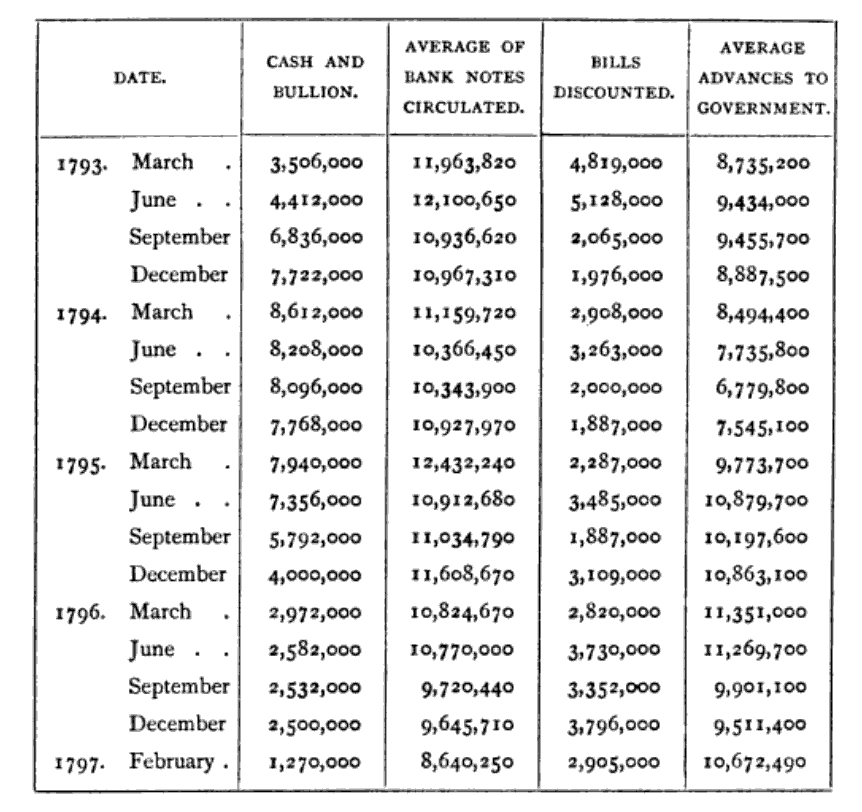
In the beginning of 1798, the Bank advanced to government 3,000,000/. of exchequer bills, and in the progress of the year a farther advance of 500,000/.; so that the total sum advanced by the Bank for the public service, and outstanding on the 7th of December, was 6,777,739/. At a general court held the 14th of March, 1799, it was agreed to advance to government 1,500,000/. on exchequer bills; and it was proposed to divide among the proprietors the 5 per cent, stock held by the company, for the million subscribed tthe Loyalty loan; and with this view, to purchase 39,240 /. of the same stock, to make up the sum held by them to 1,164,240/. in order to make a dividend of 10/. 5 percent, stock for every 100/. bank capital: accordingly the transfer was made on the 1st of June.
In November following, a negociation was entered into for renewing the term of the company’s charter, although about thirteen years of it remained. The proposition was agreed to at a general court held January the 9th, 1800. The conditions were, that the Bank should advance to government 3,000,000/. for the service of the year 1800, on exchequer bills, payable, without interest, out of the supplies to be granted for the year 1806: in consideration of which the term of their charter was continued till the end of twelve months’ notice after the 1st of August, 1833.
The amount of bank notes in circulation had gradually increased since the beginning of 1797, and, during the year 1800, amounted to about 15,000,000/. The amount, on an average of a month, to the 25th of January, 1801, was 16,365,200/. consisting of 13,845,800/. in notes of 51. and upwards, and 2,519,400/. in notes of 1/. and 2/. At a general court held the 19th of March, 1801, another occasional dividend of stock was proposed. This dividend was to be made of 582,120/. of 5 per cent, navy annuities, at the rate of 5 per cent, for every 100/. bank capital; and the transfer was made on the first of May.



